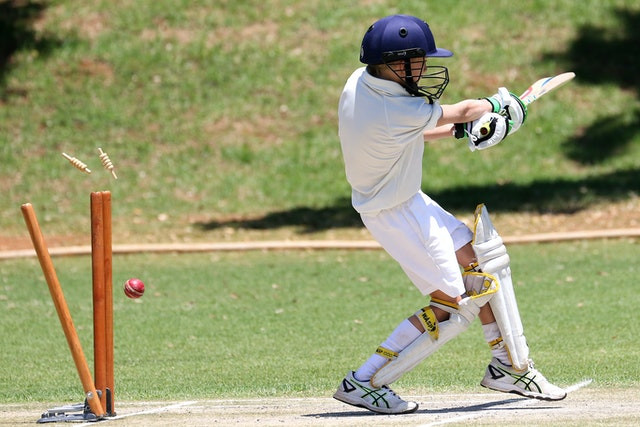There are around ten ways to get out in cricket. In cricket, if a batsman gets dismissed or out means, he needs to stop playing, and a new player needs to come to batting. So once a player gets dismissed, he needs to leave the ground and cannot play again in the same innings or match based on match type, so if a player gets dismissed in a match, that helps the bowling team. In most games, taking ten wickets helps the team finish the opposing team's innings, which allows them either win the match or helps to start their batting.
Some common ways to get out in cricket are caught, bowled, leg before wicket, etc. Here it is different ways to get out in cricket.
Bowled
The term bowled is commonly used in cricket to term the dismissal of a player when the ball hits the wicket of a striker player. So this dismissal, the bowler needs to deliver a legitimate delivery, and the ball needs to hit the wicket. In international cricket, the bails used in the stumps need to dislodge to mark the player as out. A batsman can get out even without directly hitting the stumps.
A player will get dismissed if the ball hits the player or his bat and then dislodges the bails. The player will never get dismissed if the ball hits another player before hitting the stumps.
Bowled comes under Law 32 in Cricket

Caught
This is the most common way of getting dismissed in cricket. The striker is out if these conditions are met.
- The ball needs to be a legitimate delivery (not a no-ball)
- Before touching the ground, any fielder needs to catch the ball after being hit by the striker.
- The ball is caught by any player of the opposite team preset during that ball.
- The batsman will get out if the ball hits the glows while the bat is in his hands before the fielder takes the catch.
Along with that either umpires or third umpire needs to confirm the dismissal if the batsman have any doubt about catch. In most of the cases the batsman will leave the ground once the catch is taken, but its okay for the batsman to wait for the umpires confirmation before leaving the field.
Caught comes under Law 33 in Cricket
Leg Before Wicket
Leg Before Wicket, or LBW, is introduced to prevent players from deliberately blocking the cricket ball using their body to avoid hitting it. So even if the name says leg before wicket, the rule applies to any body part, excluding the gloves. There are many rules for judging a Leg Before Wicket.
Here it is the basic rules of LBW
- The ball first hits any player part, and it should be a legal delivery.
- The ball must be in line with the stumps when it hits the player
- The ball should not pitch outside of the leg stump
- The umpire must decide if the opposing team appeals for an LBW.
- And according to new DRS rules opposing teams or batters can appeal against the on-field umpire to review it using a tv umpire.
Run Out
Another form of dismissal in cricket which has got direct involvement of a fielder in the ground. As its name suggests, a batsman gets out attempting to run between the wicket in this form of dismissal. The fielding team can run out any player by hitting the ball to stumps or removing the bails before the batter crosses the crease line when the game is in play.
Most of the time, its difficult for an on-field umpire to make a run-out decision. In that scenario, umpires can refer the decision to the tv umpire. A tv umpire can make the out/not out decision based on the replays from the match.
Caught comes under Law 38 in Cricket
Stumped
Stumped is a form of dismissal similar to run out. Stumped is only performed by a wicketkeeper. It is the scenario where a player gets dismissed. A wicketkeeper can stump out a player when a batter misses a stroke. Also, the players need to be out of the popping crease, and the wicketkeeper puts down the wicket.
Stumped comes under Law 39 in Cricket
Hit Wicket
A batter can be deemed out if the batter hits the stump with a bat and bails are dislodged during the delivery. This is not just limited to cricket bats. A batsman gets out by hitting any part of his body, including helmets and other equipment a player uses.
This is a rare form of dismissal in cricket, where players get out in a hit-wicket format. And the delivery must be a legal delivery to be deemed as the wicket.
Hit Wicket comes under Law 36 in Cricket
Retired Out
Have you ever heard of Retired hurt in cricket? In retired hurt, a batter can leave the ground for a genuine reason with permission from the umpire and come back later in the innings to play again. Retired out is somewhat similar to it. But here, a player leaves the ground without permission from the umpire. In that scenario, the player will be deemed out and can not bat again in that same innings.
Obstructing the Field
This is one form of dismissal which got into many controversies. As its name suggests, umpires or the tv umpire can dismiss a player for obstructing the field. This law only applies in case of a batsman willfully obstructs the field.
These scenarios are common when it comes to this kind of wicket. A player can obstruct a fielder when he tries to take a catch in the 22 yards or near around it. This can also happen in case if the any of the man obstructs the fielder in case of run out attempt as well.
Obstructing the Field comes under Law 37 in Cricket.
Handled the ball was formerly one of the methods of dismissing a batsman in the sport of cricket, but was integrated into the Law on obstructing the field when the Laws of Cricket were rewritten in 2017.
Hit the Ball Twice
Like Obstructing the field, "Hit the Ball twice" is another form of dismissal where a batsman hits the twice. This law also applies when the batsman deliberately strikes the ball after he has played the ball for the first time. This also applies if the ball touches any part of the player before deliberately playing for the second time.
There is an exception to this rule. A batsman can use their bat or any part of the body other than their hands to prevent the ball from hitting the stumps. This is considered legal in cricket and is okay in cricket.
Hit the Ball Twice comes under Law 34 in Cricket
Timed Out
One of the rare forms of dismissal in cricket. Time out rule says after a batter's wicket falls, the incoming batter must be ready to receive the ball, or the other batter must be prepared to receive the next ball within 3 minutes of the dismissal. If this requirement is not met, the incoming batter will be out, Timed out.
There is an exception to this rule. This applies unless Time has been called after the wicket, and this rule also applies in the case of retired hurt.
Conclusion
We already discussed different forms of dismissals or ways of getting out in this extensive article. If you have anything to discuss regarding this article, feel free to comment in the comment section.





